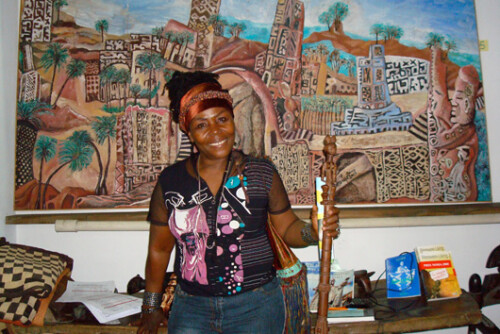From the fifth Scholar & Feminist – Creating Feminist Works – through the twenty-third – Women in Film: Images and Images Makers – to the twenty-ninth – Power and Representation in a Media-Saturated Age – the Center has been vitally interested in how feminist artists, performers and media-makers both inspire and answer the call for social change. Moderated by Ann Cvetkovich, Professor of English and Women’s and Gender Studies at the University of Texas at Austin, this panel brought together a remarkable lineup of feminist writers, performers, and media-makers to discuss the necessity, importance and endless possibilities of feminist cultural production. Participants included:
- Meena Alexander, poet
- Dorothy Allison, novelist
- Tammy Rae Carland, video artist
- Staceyann Chin, spoken word poet
- Elaine Kim, Professor of Asian American Studies at the University of California, Berkeley
Professor Ann Cvetkovich opened this lively conversation with the following question: if creativity is our birthright, if it belongs to all of us, then what distinguishes “people who have chosen, in some way, to make creativity a part of the work they do, in many cases, as professionals”: in short, what makes an artist? For each of the panelists, even those who are reluctant to call themselves artists, art is a matter of survival. For Staceyann Chin, the discovery of the writings of Toni Morrison and Sylvia Plath, connected her to a long history of women struggling not only for their voices but for a place in the world in which to raise them. Dorothy Allison spoke of the fate that befalls those who, for lack of money or time or resources, never find a means of expressing their stories: “all the women in my family have had that kind of maddening passion, and it killed most of them. Because there was no place for them to take their art, and nothing to be done with it except go mad or slap their kids around.” And it’s exactly these stories that we, as a society, need. Poetry may well be, as Meena Alexander claims, “the music of survival,” but the panelists make clear that all art is a means of survival not only for those who produce it but for those who consume it as well. By providing an antidote to the slick, entertainment-based and often meaningless narratives pedaled by the media, artists offer up a vision of reality that “it would be impossible to live without.”
From here, the conversation turned to the topic of funding and resources, for although everyone may have “something vital” to express, few have the financial means to do so. This issue becomes particularly important to feminist-identified artists now that, thirty years into the feminist movement, many of the structures that once supported that art – women’s bookstores, record-labels, art collectives – have been lost or subsumed into more mainstream and commercialist ventures. How, then, asked Ann Cvetkovich, do we continue to fund feminist artists and their works? Tammy Rae Carland spoke of the need to return to the production model prevalent during the 70s, wherein we must tap into a “drive to nuture and help put out into the world works by other people.” In describing how she and her partner started an independent record label, Mr. Lady Records, (with a mere $37.00 investment), Carland spoke openly about the sacrifices that she had to make in terms of her own artistic production, but assured the audience that the sacrifices were worth it in order to provide consumers with projects that, in a world driven by the commercial interests of giant conglomerates, would otherwise go “unrecorded and unacknowledged.” Both Meena Alexander and Staceyann Chin addressed the delicate and often dubious system of checks and balances by which artists are financially rewarded, Chin admitting to struggling with the suspicion that artists are often chosen like “a flavor of the month,” their work acknowledged less for its own merit than for the fact that they happen to fit a desired (racial, ethnic, religious, physical, etc., etc.) niche.
Unarguably, an artist’s politics also play a significant role in whether s/he will be awarded, denied or stripped of funding. Professor Cvetkovich then asked the panelists to consider the connection between politics and their work. Elaine Kim began by relating her concerns that the disparaging of identity politics, a current trend particularly in the academy, precludes us from seeing the importance of issues of identity to narratives that have the power to link the individual to larger communities. Instead of viewing life of the singular citizen as an entryway into the concerns of the communities of which she is a part, Americans favor an “aberrational individualism” that denies the complex interrelatedness that is a reality of people’s lives. Staceyann reiterated this point, insisting that it is the artist’s duty to move our understanding of the world beyond simple stereotypes. It is particularly important that American’s learn to broaden, complicate and revise their vision of the world, for, as Staceyann warned, “there is a grand sense [that] the people who are in charge of America do not care about the rest of the world. And that’s at the center of the axis upon which America will fall.”
Text: Full Transcript (PDF, 164 KB)
Video Clips: Play Clip 1
Ann Cvetkovich, Staceyann Chin, and Tammy Rae Carland discuss what it means to be an “artist” and how notions of feminism have changed that term Play Clip 2
Tammy Rae Carland discusses the development of her own record label and the connection between “material support” and making art Play Clip 3
Ann Cvetkovich, Elaine Kim, Meena Alexander and Dorothy Allison address the artist’s role(s) in politics and movements for social justice



